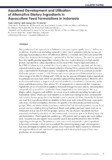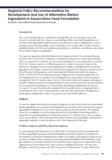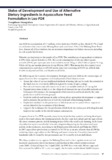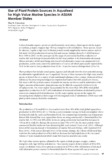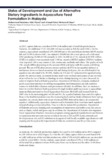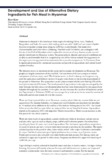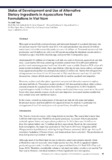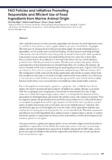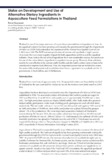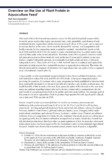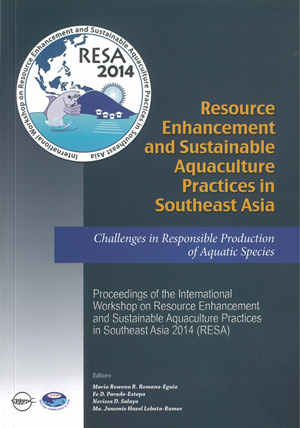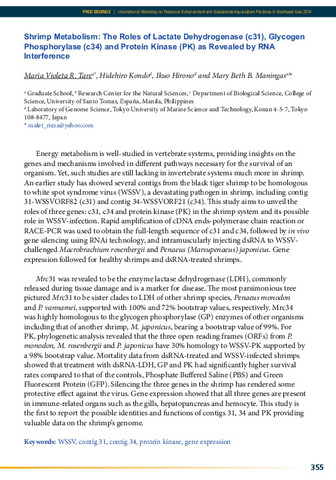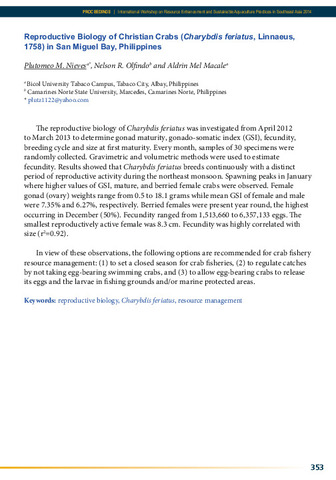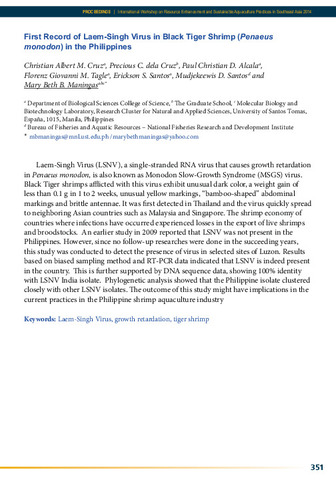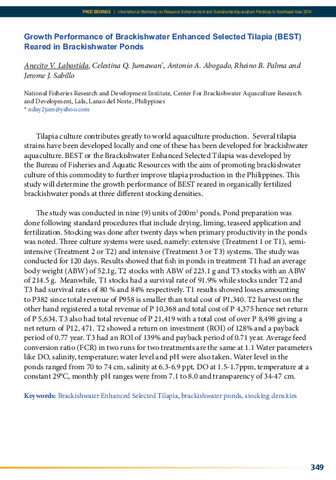Conference Proceedings: Recent submissions
261-280 / 767
-
Aquafeed development and utilization of alternative dietary ingredients in aquaculture feed formulations in Indonesia
(Aquaculture Department, Southeast Asian Fisheries Development Center, 2015)Fish production from aquaculture in Indonesia continues to grow rapidly from 1.7 million mt in 2009 to 4.0 million mt (excluding seaweed) in 2013. This is consistent with the increase of total aqua feed production from ... -
Status of development and use of alternative ingredients in aquaculture feed formulations in Singapore
(Aquaculture Department, Southeast Asian Fisheries Development Center, 2015)The aquaculture industry in Singapore started in 1980s. The country has approximately 130 aquaculture farms, mostly located in the western part of the country. Aquaculture production mainly comes from coastal farms and the ... -
Regional policy recommendations for development and use of alternative dietary ingredients in aquaculture feed formulation
(Aquaculture Department, Southeast Asian Fisheries Development Center, 2015)The paper presents the key problems on development and use of alternative dietary ingredients in aquaculture feed formulations in Southeast Asia based on the discussion and reviews during the Regional Technical Consultation. ... -
Use of plant proteins in aquaculture feed for top five commodities in ASEAN member states
(Aquaculture Department, Southeast Asian Fisheries Development Center, 2015)Fish production from aquaculture in Asia has steadily increased during the past decade. In 2012, Asia s share in the total world aquaculture production was about 89% with 60 M metric tons valued at US$ 120 B. ASEAN Member ... -
Status of development and use of alternative dietary ingredients in aquaculture feed formulation in Lao PDR
(Aquaculture Department, Southeast Asian Fisheries Development Center, 2015)Lao PDR has a population of 5.7 million, with a land area 236,800 sq. km. About 87.7% of land or catchment areas drains into Mekong River and contributes 35% of the Mekong River Basin flow. Almost all of Laos territory has ... -
Use of plant protein sources in aquafeed for high value marine species in ASEAN member states
(Aquaculture Department, Southeast Asian Fisheries Development Center, 2015)Cultured marine aquatic species are predominantly carnivorous. Major species in the region are seabass, grouper, snapper, tiger shrimp, mangrove crab and abalone. These species, except for abalone, require a high level of ... -
A new type of fish diet, non-fish meal extruded pellet for yellowtail, Seriola quinqueradiata
(Aquaculture Department, Southeast Asian Fisheries Development Center, 2015)A non-fish meal diet using plant and/or animal protein materials for yellowtail, Seriola quinqueradiata was developed. Three kinds of non-fish meal diets and a control diet containing 50% fish meal were processed. In the ... -
Status and development and use of alternative dietary ingredients in aquaculture feed formulation in Malaysia
(Aquaculture Department, Southeast Asian Fisheries Development Center, 2015)In 2013, capture fisheries contributed 85% (1.48 million mt) of total fish production in Malaysia. An additional 17.6% (261,000 mt) was recorded as fish-by-catch (FBC). On the contrary, aquaculture contributed 15% (260,800 ... -
Status of development and use of alternative dietary ingredients in aquaculture feed formulations in Cambodia
(Aquaculture Department, Southeast Asian Fisheries Development Center, 2015)Aquaculture production has been practised in Cambodia for centuries where usually high value fish are grown in cages and fed low value fish. The use of low value fish or trash fish as feed also provides a storage mechanism ... -
Development and use of alternative dietary ingredients for fish meal in Myanmar
(Aquaculture Department, Southeast Asian Fisheries Development Center, 2015)Myanmar is situated in the Southeast Asian region bordering China, Laos, Thailand, Bangladesh and India. It covers a fish landing total area of 677,000 km2 and about 526,000 hectares of marine swamp areas along its 2,800 ... -
Status on development and use of alternative dietary ingredients in aquaculture feed formulations in Viet Nam
(Aquaculture Department, Southeast Asian Fisheries Development Center, 2015)This paper reviewed fish catch production and estimated demand of aquafeed, fish meal, fish oil, soybean meal in Viet Nam for year 2013. Fish catch production was around 2.8 million metric tons (mt) while marine fish ... -
Processing of alternative feed ingredients in aquaculture feed
(Aquaculture Department, Southeast Asian Fisheries Development Center, 2015)Fish meal and fish oil have been used worldwide in aquaculture feed formulations. Production of these ingredients has been relatively constant for decades. However, supplies of industrial fisheries are limited, and unlikely ... -
FAO policies and initiatives promoting responsible and efficient use of feed ingredients from marine animal origin
(Aquaculture Department, Southeast Asian Fisheries Development Center, 2015)After rapid development for three decades, aquaculture has become the most important source of food fish in Asia, which currently supplies about 55 per cent of food fish for the people. The rapid growth of aquaculture ... -
Status on development and use of alternative dietary ingredients in aquaculture feed formulations in Thailand
(Aquaculture Department, Southeast Asian Fisheries Development Center, 2015)Thailand is one of the major producers of aquaculture commodities and aquafeeds in Asia. As the aquafeed industry has been growing continuously, the government through the Department of Fisheries (DOF) had undertaken the ... -
Overview on the use of plant protein in aquaculture feed
(Aquaculture Department, Southeast Asian Fisheries Development Center, 2015)Fish meal (FM) is the best and main protein source for fish and shrimp feed because of the favorable amino acid profile, highly unsaturated fatty acids, palatability and absence of antinutritional factors. Aquaculture ... -
Resource enhancement and sustainable aquaculture practices in Southeast Asia: challenges in responsible production of aquatic species : proceedings of the international workshop on resource enhancement and sustainable aquaculture practices in Southeast Asia 2014 (RESA)
(Aquaculture Department, Southeast Asian Fisheries Development Center, 2015-08)The conference was held in order to promote and augment regional initiatives on resource enhancement and sustainable aquaculture practices, and to contribute to poverty alleviation, livelihood and food security in Southeast ... -
Shrimp metabolism: The roles of lactate dehydrogenase (c31), glycogen phosphorylase (c34) and protein kinase (PK) as revealed by RNA interference
(Aquaculture Department, Southeast Asian Fisheries Development Center, 2015)Energy metabolism is well-studied in vertebrate systems, providing insights on the genes and mechanisms involved in different pathways necessary for the survival of an organism. Yet, such studies are still lacking in ... -
Reproductive biology of christian crabs (Charybdis feriatus, Linnaeus, 1758) in San Miguel Bay, Philippines
(Aquaculture Department, Southeast Asian Fisheries Development Center, 2015)The reproductive biology of Charybdis feriatus was investigated from April 2012 to March 2013 to determine gonad maturity, gonado-somatic index (GSI), fecundity, breeding cycle and size at first maturity. Every month, ... -
First record of Laem-Singh virus in black tiger shrimp (Penaeus monodon) in the Philippines
(Aquaculture Department, Southeast Asian Fisheries Development Center, 2015)Laem-Singh Virus (LSNV), a single-stranded RNA virus that causes growth retardation in Penaeus monodon, is also known as Monodon Slow-Growth Syndrome (MSGS) virus. Black Tiger shrimps afflicted with this virus exhibit ... -
Growth performance of brackishwater enhanced selected tilapia (BEST) reared in brackishwater ponds
(Aquaculture Department, Southeast Asian Fisheries Development Center, 2015)Tilapia culture contributes greatly to world aquaculture production. Several tilapia strains have been developed locally and one of these has been developed for brackishwater aquaculture. BEST or the Brackishwater Enhanced ...

